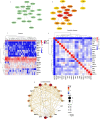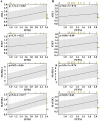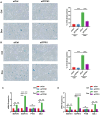Correlation between Mitochondria-Associated Endoplasmic Reticulum Membrane-Related Genes and Cellular Senescence-Related Genes in Osteoarthritis
- PMID: 38708239
- PMCID: PMC11064197
- DOI: 10.1021/acsomega.3c10316
Correlation between Mitochondria-Associated Endoplasmic Reticulum Membrane-Related Genes and Cellular Senescence-Related Genes in Osteoarthritis
Abstract
Background: The role of mitochondria-associated endoplasmic reticulum membrane (MAM) formation in the development of osteoarthritis (OA) is yet unclear.
Methods: A mix of bioinformatics methods and in vitro experimental methodologies was used to study and corroborate the role of MAM-related genes and cellular senescence-related genes in the development of OA. The Gene Expression Omnibus database was used to obtain the microarray information that is relevant to the OA. Several bioinformatic methods were employed to carry out function enrichment analysis and protein-protein correlation analysis, build the correlation regulatory network, and investigate potential relationships between MAM-related genes and cellular senescence-related genes in OA. These methods also served to identify the MAM-related and OA-related genes (MAM-OARGs).
Results: For the additional functional enrichment analysis, a total of 13 MAM-OARGs were detected. The correlation regulatory network was also created. Hub MAM-OARGs were shown to have a strong correlation with genes relevant to cellular senescence in OA. Results of in vitro experiments further demonstrated a positive correlation between MAM-OARGs (PTPN1 and ITPR1) and cellular senescence-related and OA-related genes.
Conclusions: As a result, our findings can offer new insights into the investigations of MAM-related genes and cellular senescence-related genes, which could be linked to the OA as well as brand-new potential treatment targets.
© 2024 The Authors. Published by American Chemical Society.
Conflict of interest statement
The authors declare no competing financial interest.
Figures









Similar articles
-
Identification and Validation of Key Genes Involved in the Coupling of Mitochondria-Associated Endoplasmic Reticulum Membrane in Hemorrhoidal Disease.Int J Gen Med. 2025 May 31;18:2781-2798. doi: 10.2147/IJGM.S511281. eCollection 2025. Int J Gen Med. 2025. PMID: 40469970 Free PMC article.
-
A Novel Role for Protein Tyrosine Phosphatase 1B in Alleviating Chondrocyte Senescence.ACS Omega. 2024 Jun 13;9(25):27017-27029. doi: 10.1021/acsomega.3c10313. eCollection 2024 Jun 25. ACS Omega. 2024. PMID: 38947824 Free PMC article.
-
Screening of Biomarkers Associated with Osteoarthritis Aging Genes and Immune Correlation Studies.Int J Gen Med. 2024 Jan 20;17:205-224. doi: 10.2147/IJGM.S447035. eCollection 2024. Int J Gen Med. 2024. PMID: 38268862 Free PMC article.
-
The Molecular Mechanisms Underlying Mitochondria-Associated Endoplasmic Reticulum Membrane-Induced Insulin Resistance.Front Endocrinol (Lausanne). 2020 Nov 23;11:592129. doi: 10.3389/fendo.2020.592129. eCollection 2020. Front Endocrinol (Lausanne). 2020. PMID: 33329397 Free PMC article. Review.
-
Where the endoplasmic reticulum and the mitochondrion tie the knot: the mitochondria-associated membrane (MAM).Biochim Biophys Acta. 2013 Jan;1833(1):213-24. doi: 10.1016/j.bbamcr.2012.04.013. Epub 2012 May 2. Biochim Biophys Acta. 2013. PMID: 22575682 Review.
Cited by
-
Integrated bioinformatics and experimental analysis of mitochondrial-associated membrane function and mechanism in acute respiratory distress syndrome.Sci Rep. 2025 Jul 9;15(1):24602. doi: 10.1038/s41598-025-10405-3. Sci Rep. 2025. PMID: 40634559 Free PMC article.
References
-
- Zhao B.; Zhang Q.; He Y.; Cao W.; Song W.; Liang X. Targeted metabolomics reveals the aberrant energy status in diabetic peripheral neuropathy and the neuroprotective mechanism of traditional Chinese medicine JinMaiTong. J. Pharm. Anal. 2024, 14 (2), 225–243. 10.1016/j.jpha.2023.09.007. - DOI - PMC - PubMed
-
- Liang X.-L.; Ouyang L.; Yu N.-N.; Sun Z.-H.; Gui Z.-K.; Niu Y.-L.; He Q.-Y.; Zhang J.; Wang Y. Histone deacetylase inhibitor pracinostat suppresses colorectal cancer by inducing CDK5-Drp1 signaling-mediated peripheral mitofission. J. Pharm. Anal. 2023, 13 (10), 1168–1182. 10.1016/j.jpha.2023.06.005. - DOI - PMC - PubMed
LinkOut - more resources
Full Text Sources
Research Materials
Miscellaneous
